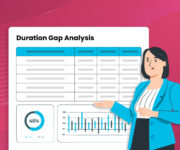A bank statement gives a view of all the transactions undertaken by the account holder including deposits, withdrawals, transfers, debit card payments, interest earned, bank service fees, as well as the other installments they are paying over a fixed span of time. All prospective lenders ask for a copy of the applicant’s bank statement from the last 3-6 months.
Bank statement analysis can unearth critical financial information when assessing a loan applicant’s eligibility for a loan.
How Do Lenders Analyze Bank Statements?
Lending businesses play with risks all the time. That is why they need to weigh the pros and cons of every loan application thoroughly before they allocate funds to applicants. Bank statement analysis is the most basic approach towards accessing a loan applicant’s creditworthiness and consequently, lending risk management.
Here in this article, we discuss how bank statement analysis aids lending risk management:
1. Bank Statement Analysis for Cash Balance
The loan application evaluation process includes accessing the positive cash balance in the bank account statement of an applicant. The cash balance indicates the amount of money available to the borrower at a given moment. The Cash balance is a clear indicator of how well an applicant manages their cash flow. Lenders assume that borrowers who maintain a positive cash balance over some period of time can be labelled as ‘responsible’ ones. Consequently, a positive cash balance on the bank statement increases the chances of loan repayment in the future.
In the same way, negative cash balances on the bank statement of an applicant present a picture of mismanagement of finances. A negative cash balance on a bank statement is a big red flag for lenders. While there is no standard cash balance that an applicant must maintain to avail a loan from a lender, it depends on the amount of credit he/she has applied for. In simple words, the balance a borrower maintains on his bank statement should be proportional to the loan amount an applicant has used for.
2. Bank Statement Analysis for Deposits
Lenders believe it is essential to mark down natural deposit sources on bank statements for proper lending risk management. It is commonly thought that monthly deposits are an indicator of an applicant’s steady sources of income. Moreover, fat deposits on an applicant’s bank statements often indicate profitable operations and consistent revenue streams. Lenders analyze bank statements for regular, steady deposits. Recurring deposits suggest that there is an increased chance that they will make on-time monthly repayments if the loan is issued.
If a lender figures out that the last deposit was made months ago on a bank statement, they assume unsustainability and inconsistency in income sources. It is a red flag for evaluators as it indicates diminishes chances of timely loan repayments. Even irregular large deposits or sparse deposits made into the bank account before the time of loan application do not particularly impress lenders.
3. Bank Statement Analysis for Withdrawals and Liabilities
Lenders critically analyze the bank statement for any significant withdrawals made from the bank account of an applicant before the loan application. They also look for frequent withdrawals of a similar amount from a particular bank account, as it arouses suspicion about some undisclosed loan, credit card debts or recurring expenses that need to be paid off on a regular basis. Often lenders also deduct business liabilities from the average monthly profit to achieve a realistic view of the bank statement.
While most liabilities can be a recurring cost, some regular ones like office expenses are counted in a positive light by lenders. An application evaluator must inquire borrowers about any liabilities which are not disclosed in the bank statements. A bank statement showcasing regular withdrawals and liability payments tantamounting to less than regular deposits are considered eligible for a loan due to their capability of being able to pay it back.
4. Bank Statement Analysis for Cash Overdrafts
Borrowers are at liberty to withdraw money from their bank account using a bank’s cash overdraft facility. Supposedly, a loan applicant writes a cheque for funds that are not available in their report, a cash overdraft facility usually applies in that case. Lending risk management includes accessing bank statements and pointing at such overdrafts on an applicant’s bank statement.
It indicates how well an applicant manages his finances. Lenders think that overdraft suggests there is a likeliness of difficulty in repaying the loan.
Conclusion
Although lending companies follow different guidelines passed down to them for bank application analysis. Additionally, the bank statement of loan applicants is an essential factor that the lenders access during a loan application assessment. Bank statements adequately showcase a borrower’s financial standing along with their spending habits and cash flow management practices. Risk-free lending practices include the use of bank statement analysis for an in-depth assessment. Lenders tend to choose applicants with a positive bank statement featuring positive cash balance, regular deposits, and no several overdraft months, etc.
Finezza is a lending management software that offers a unique Bank Statement Analysis (BSA) functionality a.k.a. Precisa as its core function. Finezza analyzes the deep topical domain that helps in credit evaluation. The framework makes the final lending decisions on behalf of the lending partner. It takes into account insights from the transaction history and data of a borrower. Finezza also creates multiple visualizations and insightful reports for the benefit of the lender’s evaluation process. The specialized lending management software red flags fraudulent statements, circular transactions, irregular payment patterns, transactions, and other such discrepancies that an applicant’s bank statement project. Overall, the system develops a keen understanding of the operations and the data on a unit basis.
Wholesome mobile analytic functionalities help the credit evaluation teams at a lending company develop a better understanding of a prospect’s creditworthiness. Finezza helps lenders predict chances of successful loan repayments efficiently. The unique software tool boasts of knowledge and analyzing formats of more than 400 banks from across the country.
Find out more about how Finezza can help you optimize the lending lifecycle and ease the lending process through bank statement analysis, by getting in touch with us!




[…] of credit history, frequency of bill payment, past delinquencies, and many others to estimate if an applicant is a health risk for the credit card company. It becomes hard to judge an applicant’s ability, stability, and willingness to pay a loan […]